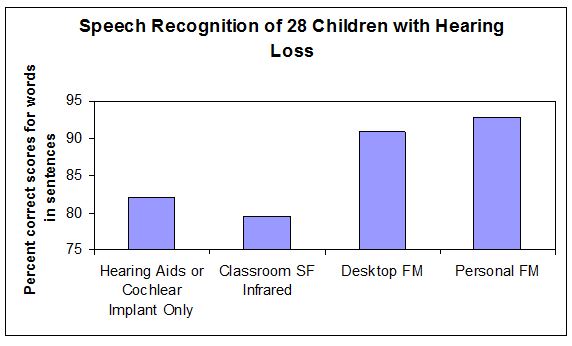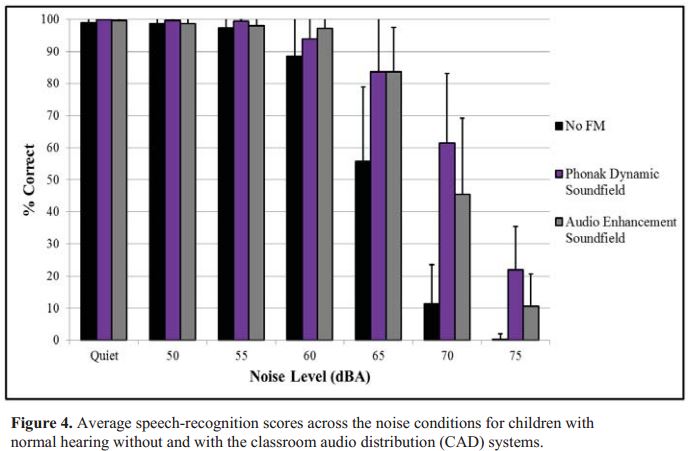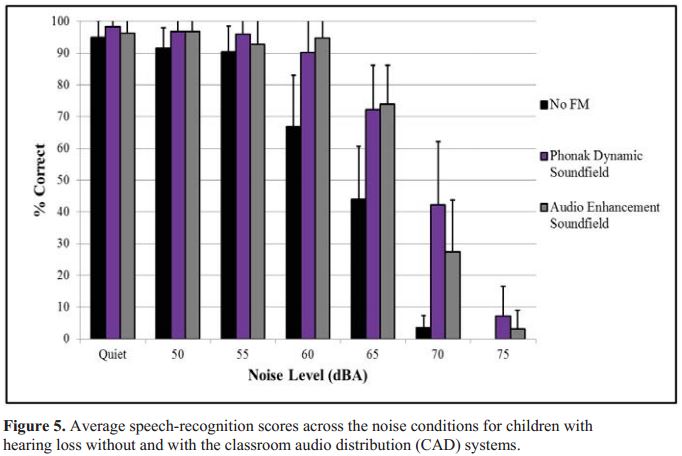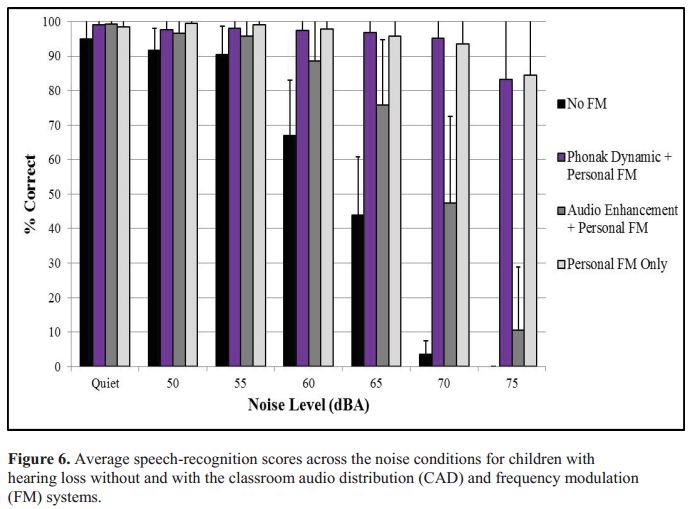Personal FM vs Sound Field FM (Classroom Audio Distribution System)
Case Law: K.M. v. Tustin Unified School District (9th Cir. 2013) Compliance with the IDEA does not necessarily demonstrate compliance with Title II of the ADA. Districts must ensure that communication with hearing impaired students is as effective as with non-disabled students. Districts must provide auxiliary aids and services necessary to afford equal access.
The debate about personal FM versus sound field FM has waged since the late 1980s when sound field amplification systems began to appear in increasing numbers of classrooms throughout the US. Sound field amplification, or Classroom Audio Distribution Systems (CADS), provide improved audibility of the teacher’s voice for ALL children, not just the child with hearing loss, at 1/4 to 1/2 the cost of a personal FM system. The child with hearing loss is not singled out as the only one to benefit from amplification of the teacher’s voice. From a school budget standpoint it is not a surprise that purchase of CADS is often preferred over a personal sound field system. But the real question is whether it will provide the same benefit in allowing the student to access verbal instruction equal to class peers.
Some key research answers this question clearly as NO. In a typically noisy classroom a child with hearing loss requires personal FM. CADS use can actually be detrimental to speech perception. The ONLY technology to provide communication as effective as typically hearing students is the personal FM system, unless the classroom has unusually low noise/reverberation levels. Until schools prioritize appropriate acoustic conditions in classrooms, personal FM is necessary for equal/optimized access to verbal instruction. Karen Anderson, Director
Research to Support Use of Personal FM to Improve Classroom Listening (not sound field amplification)
 Summary of 3 FM Study Comparing Speech Perception in a Typical Classroom for Children with Hearing Aids or Cochlear Implants Information from three
Summary of 3 FM Study Comparing Speech Perception in a Typical Classroom for Children with Hearing Aids or Cochlear Implants Information from three
experiments that indicate desktop FM or personal FM use results in better speech perception than using sound field amplification or hearing aids or cochlear implants alone.
From Australian Hearing: Personal FM or Soundfield Amplification? A short summary of research.
ARTICLE:Benefit of S/N Enhancing Devices to Speech Perception of Children Listening in a Typical Classroom with Hearing Aids or a Cochlear Implant Journal of Educational Audiology, 12 (2005)
ARTICLE: Speech Perception Benefits of FM and Infrared Devices to Children with Hearing Aids in a Typical Classroom LSHSS, 35 (2004)
ARTICLE: Improvements in Speech Recognition Using Cochlear Implants and Three Types of FM Systems: A Meta-Analysis. J. Educ. Audiol, 15; 4-14 (2009). For students with cochlear implants: with sound field had 3.5% improvement, for desktop FM had 17.1% improvement, for Personal FM had 38% improvement.
GUIDE BOOK: How to Combine Personal FM and Classroom Sound Systems (2013).
Evaluation of Speech Recognition with Personal FM and Classroom Audio Distribution Systems
Study authors: Jace Wolfe, Ph.D., Mila Morais, Au.D., Sara Neumann, Au.D., Erin Schafer, Ph.D., Dr. Hans E. Mülder, Nathan Wells, B.Sc., Andrew John, Ph.D., and Mary Hudson, Ph.D. Journal of Educational Audiology vol. 19, 2013, pg 65-79
Child participants in study: 15 children with normal hearing (mean age: 8 years; range: 5-12 years of age), and 13 children with hearing loss (mean age: 9.5 years; range: 6-13 years of age).
Comparison of speech perception of HINT sentences with: (1) no hearing assistance technology (personal hearing devices were worn), (2) fixed-gain, multiple-loudspeaker infrared CAD system: The Audio Enhancement Elite II, (3) Adaptive single-tower array digital CAD system: The Phonak DigiMaster (DM) 5000, (4) . Personal FM: The Phonak Dynamic MLxi personal FM system
Conclusions:
 (1) Adults with normal hearing understood speech in noise better than children with normal hearing. Adults and children with normal hearing both experienced some difficulty understanding speech in moderate to high level noise (unfavorable SNR; e.g., -1 dB to -6 dB SNR) via audition alone.
(1) Adults with normal hearing understood speech in noise better than children with normal hearing. Adults and children with normal hearing both experienced some difficulty understanding speech in moderate to high level noise (unfavorable SNR; e.g., -1 dB to -6 dB SNR) via audition alone.
(2) Children with normal hearing understood speech in noise better than children with hearing loss. Children with hearing loss experienced difficulty understanding speech at noise levels and SNRs commonly encountered in typical classroom settings.
(3) CAD systems improved speech recognition in noise for children with hearing loss and also for children and adults with normal hearing.
 (4) An adaptive, digital CAD system with a single-tower array of loudspeakers has the potential to provide equal or better speech recognition in noise than fixed-gain, infrared CAD system with multiple loudspeakers.
(4) An adaptive, digital CAD system with a single-tower array of loudspeakers has the potential to provide equal or better speech recognition in noise than fixed-gain, infrared CAD system with multiple loudspeakers.
(5) Personal FM provided significantly greater improvement in speech recognition in noise than what is obtained from use of CAD systems.
(6) Combined use of the adaptive, digital single-tower CAD system + Personal FM (each was designed by the same manufacturer) provided better performance in noise than combined use of the fixed-gain, infrared CAD system with multiple loudspeakers + Personal FM (each system d esigned by a different manufacturer). In other words, it was evident that use of the CAD system negated some of the benefit provided by the personal FM system. It is important for educational audiologists to administer validation measures to evaluate performance and benefit of remote microphone technology when CAD systems and personal FM systems are used simultaneously. This study suggests that this validation is particularly important when combining personal FM and CAD systems manufactured by two different companies.
esigned by a different manufacturer). In other words, it was evident that use of the CAD system negated some of the benefit provided by the personal FM system. It is important for educational audiologists to administer validation measures to evaluate performance and benefit of remote microphone technology when CAD systems and personal FM systems are used simultaneously. This study suggests that this validation is particularly important when combining personal FM and CAD systems manufactured by two different companies.
(7) There was little to no improvement in speech recognition in noise with simultaneous use of a Phonak CAD system and personal FM system compared to performance with a personal FM alone. [No evidence basis to support provision of BOTH personal FM and CADS for students with hearing loss.]
[No evidence basis to support provision of BOTH personal FM and CADS for students with hearing loss.]
